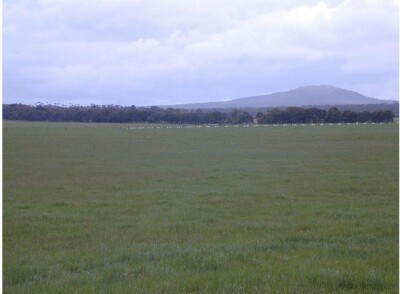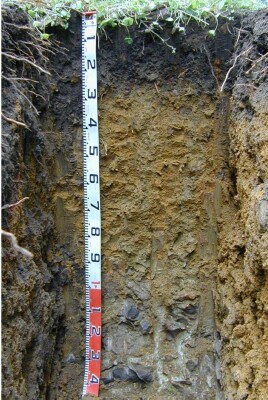KAN98 (Plot 2)
| Site: KAN98 (Plot 2) | Land Unit: Warrabkook Basalts |
| Aust. Soil Class.: | |
 | General Land Unit Description: This land unit consists of gently undulating basalt plains in the Macarthur area. In some drainage lines, the basalt has been dissected sufficiently to expose the underlying sediments. The soils on the basalt plains are commonly Brown Kurosols or Chormosols, intermixed with Sodosols, particularly on the lower slopes and drainage depressions. This site has two year old Eucalyptus globulus in a plantation on ex-agricultural land. |
Site Description:
| Geology: Quaternary basalt | Landform pattern: Level plain |
| Position in landscape: | Internal drainage: |
Soil Profile Morphology
| A1 | 0-10 cm | Very dark grey (10YR3/1) clay loam, weak polyhedral structure (10-20 mm) parting to weak granular structure (5-10 mm), very weak consistence when moist, few medium ferruginous nodules, common fine macropores, areal porosity 0.3%, many medium roots, clear and smooth transition to: |  |
| A2 | 10-22 cm | Very dark greyish brown (10YR3/2) clay loam, unable to assess structure or consistence due to segregations present, moist, many medium ferruginous nodules, common subangular moderately strong cobbles, common medium roots, abrupt and smooth transition to: | |
| Subsoil | |||
| B21 | 22-70 cm | Yellowish brown (10YR5/6) with common medium distinct red (2.5YR5/7) mottles, medium clay, moderate polyhedral structure (20-50 mm) parting to moderate granular structure (5-10 mm), weak consistence when moderately moist, few medium ferruginous nodules, common subangular moderately strong cobbles, common fine macropores, areal porosity 0.4%, few medium roots, diffuse and smooth transition to: | |
| B22 | 70-100 cm | Pale brown (10YR6/3) with common medium faint yellowish brown (10YR5/7) and red (2.5YR4/8) mottles, medium heavy clay, moderate polyhedral structure (20-50 mm) parting to moderate granular structure (5-10 mm), very weak consistence when moderately moist, few medium ferruginous nodules, common subangular moderately strong cobbles, common very fine macropores, areal porosity 0.2%, few very fine roots, clear and smooth transition to: | |
| C | 100-140 cm | Light grey (10YR7/1), light clay, unable to assess structure and macroporosity due to very abundant coarse fragments, very weak consistence when moist, very abundant subangular moderately strong cobbles, few very fine roots. | |
| 140-220 cm | Similar to layer above. | ||
| 220-410 cm | Mixed mottled clays and decomposing vesicular basalt, the basalt between 100-220 cm is most likely a large floater, live roots observed to 410 cm. |


